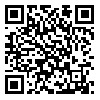BibTeX | RIS | EndNote | Medlars | ProCite | Reference Manager | RefWorks
Send citation to:
URL: http://jpcp.uswr.ac.ir/article-1-439-fa.html
Objective: The present study aimed at investigating the relationship between attachment styles and self-efficacy in blind and non-blind female high school students in Tehran.
Methods: The statistical population consisted of all female students studying in grades one or two in Tehran girl’s high schools, in the academic year 2014. The study design was causal-comparative, conducted on 120 subjects consisting of 60 blind girls selected through convenient sampling method and 60 non-blind girls selected through randomized clustering sampling method. Data were collected through two questionnaires of attachment styles of Collins and Read (1990) (RAAS) and self-efficacy scale (SEQ-C) of Muris. To analyze the data, descriptive (mean and standard deviation) and inferential statistics (multivariate analysis of variance) were used.
Results: The study results indicated a significant difference between blind and non-blind students’ efficacy and attachment styles. Avoidance attachment style as well as emotional, social, and public efficacy of these two groups revealed no significant difference. Moreover, the results indicated a significant difference between anxiety attachment style and emotional, social, and public efficacy of these two groups (P>0.05). Finally, a significant difference was observed between secure attachment style and emotional, social, and general efficacy of blind and non-blind students.
Conclusion: The blind and non-blind students are significantly different with regard to anxiety and secure attachment styles. However, their emotional, social, and academic self- efficacy seems to be the same. Although there was a significant difference between blind and non-blind students with regard to attachment styles, a significant association was seen between different dimensions of self-efficacy of blind and non-blind students (P<0.05).
دریافت: 1394/11/13 | پذیرش: 1395/4/26 | انتشار: 1395/7/10
| بازنشر اطلاعات | |
 |
این مقاله تحت شرایط Creative Commons Attribution-NonCommercial 4.0 International License قابل بازنشر است. |



